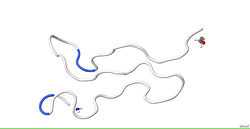Cripto
| Cripto, FRL-1, cryptic family 1B | |||||||||||||
|---|---|---|---|---|---|---|---|---|---|---|---|---|---|
 Solution structure of mouse Cripto CFC domain.[1] | |||||||||||||
| Identifiers | |||||||||||||
| Symbols | CFC1B; MGC133213; HTX2; CRYPTIC; FLJ77897 | ||||||||||||
| External IDs | OMIM: 605194 HomoloGene: 50007 GeneCards: CFC1B Gene | ||||||||||||
| |||||||||||||
| Orthologs | |||||||||||||
| Species | Human | Mouse | |||||||||||
| Entrez | 653275 | 12627 | |||||||||||
| Ensembl | ENSG00000152093 | ENSMUSG00000026124 | |||||||||||
| UniProt | P0CG36 | P97766 | |||||||||||
| RefSeq (mRNA) | NM_001079530 | NM_007685 | |||||||||||
| RefSeq (protein) | NP_001072998 | NP_031711 | |||||||||||
| Location (UCSC) | Chr 2: 131.28 – 131.29 Mb | Chr 1: 34.54 – 34.54 Mb | |||||||||||
| PubMed search | |||||||||||||
Cryptic family protein 1B is a protein that in humans is encoded by the CFC1B gene.[2][3] Cryptic family protein 1B acts as a receptor for the TGF beta signaling pathway.
Cryptic is a glycosylphosphatidylinositol-anchored coreceptor that binds nodal and the activin type I (ALK)-4 receptor (ALK4).[4]
Structure
Cripto is composed of two adjacent cysteine-rich motifs, the EGF-like and the CFC, of a N-terminal signal peptide and of a C-terminal hydrophobic region attached by a GPI anchor.[1]
NMR data confirm that the CFC domain has a C1-C4, C2-C6, C3-C5 disulfide pattern and show that structures are rather flexible and globally extended, with three noncanonical antiparallel strands.[1]
Clinical significance
CFC1B has oncogene potential.[1] Furthermore the cryptic protein is highly overexpressed in many tumors.[1]
Cripto is one of the key regulators of embryonic stem cells differentiation into cardiomyocyte vs neuronal fate.[5]
References
- ↑ 1.0 1.1 1.2 1.3 1.4 PDB 2J5H; Calvanese L, Saporito A, Marasco D, D'Auria G, Minchiotti G, Pedone C, Paolillo L, Falcigno L, Ruvo M (November 2006). "Solution structure of mouse Cripto CFC domain and its inactive variant Trp107Ala". J. Med. Chem. 49 (24): 7054–62. doi:10.1021/jm060772r. PMID 17125258.
- ↑ "Entrez Gene: cripto".
- ↑ Bonaldo MF, Lennon G, Soares MB (September 1996). "Normalization and subtraction: two approaches to facilitate gene discovery". Genome Res. 6 (9): 791–806. doi:10.1101/gr.6.9.791. PMID 8889548.
- ↑ Lonardo E, Parish CL, Ponticelli S, et al. (August 2010). "A small synthetic cripto blocking Peptide improves neural induction, dopaminergic differentiation, and functional integration of mouse embryonic stem cells in a rat model of Parkinson's disease". Stem Cells 28 (8): 1326–37. doi:10.1002/stem.458. PMID 20641036.
- ↑ Chambery A, Vissers JP, Langridge JI, et al. (February 2009). "Qualitative and quantitative proteomic profiling of cripto(-/-) embryonic stem cells by means of accurate mass LC-MS analysis". J. Proteome Res. 8 (2): 1047–58. doi:10.1021/pr800485c. PMID 19152270.
External links
- CFC1 protein, human at the US National Library of Medicine Medical Subject Headings (MeSH)
| ||||||||||||||||||||||||||||||||||||||||||